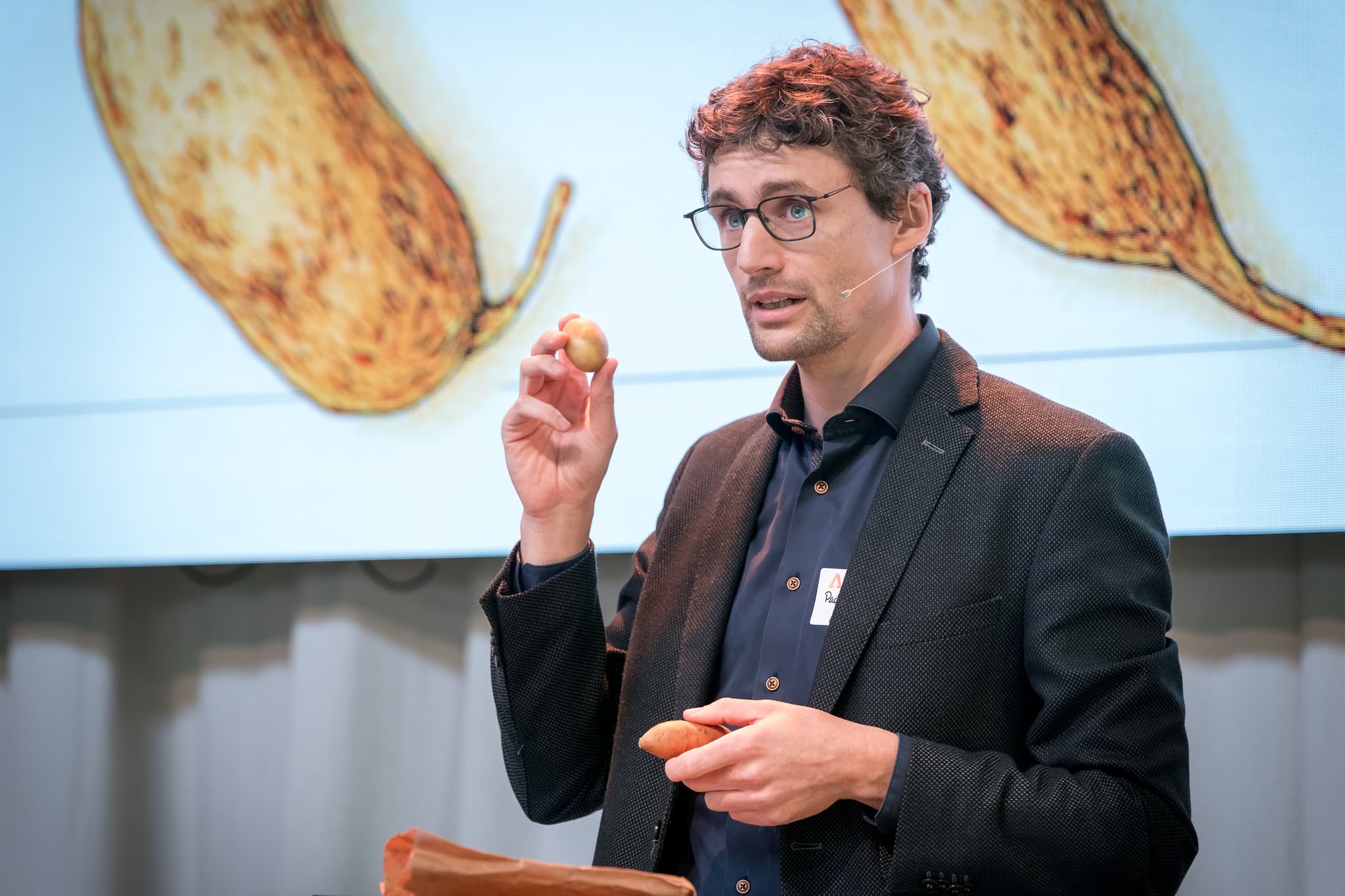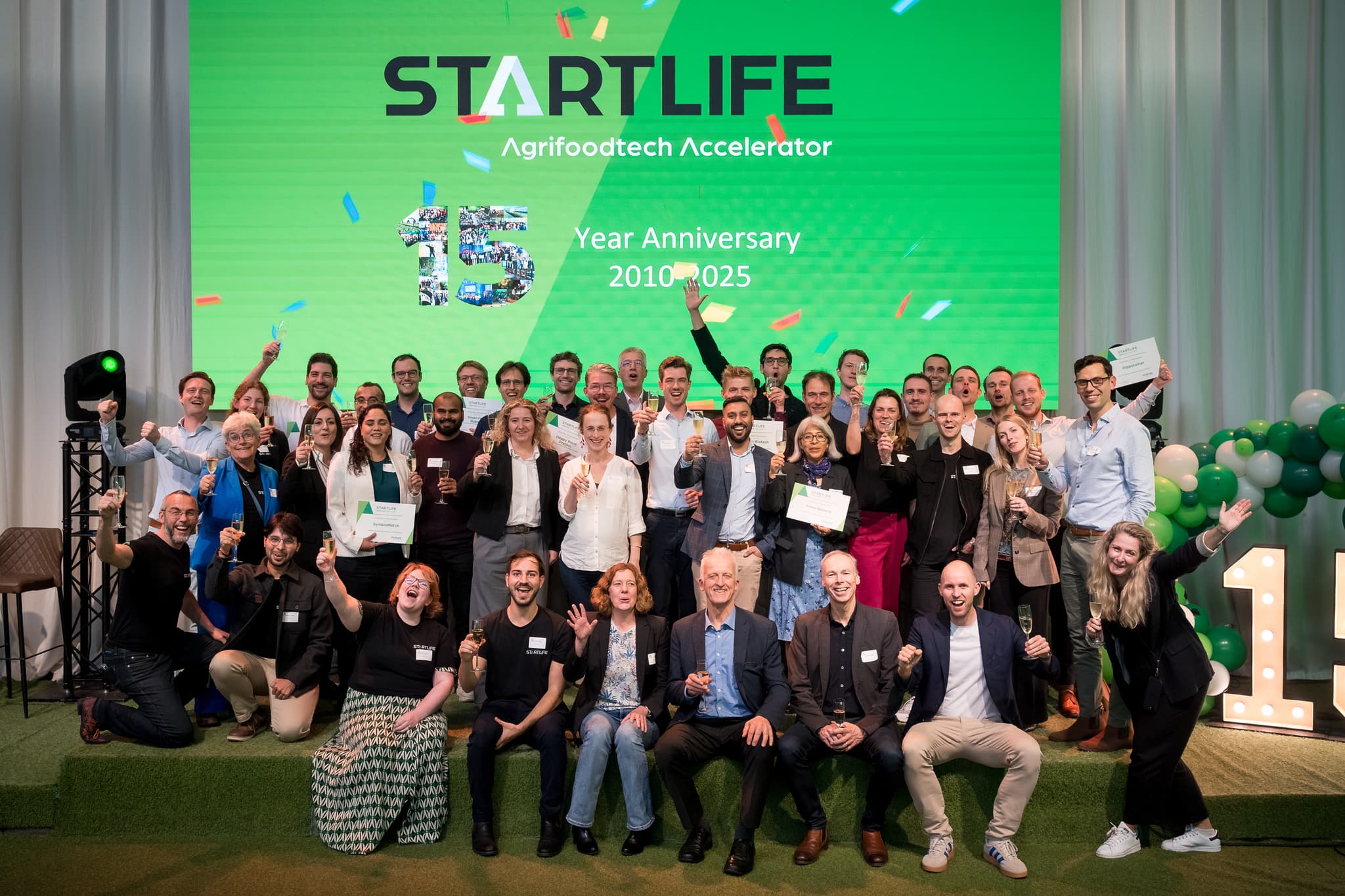Reimagining the potato: Aardaia’s mission to redesign crops
Wageningen startup introduces the protein-rich aardaker tuber – a forgotten delicacy with the potential to reshape global food systems.
Published on October 19, 2025

Aardaia © Startlife
Bart, co-founder of Media52 and Professor of Journalism oversees IO+, events, and Laio. A journalist at heart, he keeps writing as many stories as possible.
At StartLife’s 15th anniversary celebration in Ede, eleven pioneering agrifoodtech startups took the stage to show how science and entrepreneurship can reshape the future of food. From smarter biostimulants and energy-efficient farming robots to next-generation proteins and nutrient innovations, each team presented a bold solution to one of the world’s most urgent challenges: feeding a growing population within planetary limits. In this IO+ series, we highlight their stories; not just the technologies they’re building, but also their vision and the advice they received from the expert panels. Today, we focus on Aardaia.
The room was all ears when Pádraic Flood, founder of Aardaia, pulled a small, knobbly tuber from his bag. “This is an aardaker,” he announced. “It’s a nitrogen-fixing, protein-rich tuber. And it can produce five times more protein than any existing crop – without biotech or genetically modified organisms, just by tapping into what’s already out there in nature.”
It was a simple gesture, but one loaded with ambition: to reimagine agriculture itself.
From wild plants to designed crops
“All crops were once wild plants,” Pádraic reminded the audience. “They were domesticated through the sustained effort of our ancestors, often thousands of years ago. What we do at Aardaia is apply first-principles design to that process. We ask: what problem should this new crop solve?”
He illustrated the logic by holding up a potato, a sweet potato, and then a soybean. Tubers, he explained, can deliver enormous yields – more than 100 tons per hectare in ideal conditions – but they lack protein. Legumes, on the other hand, are protein powerhouses thanks to their ability to fix nitrogen. “Now imagine a crop that combines both: the yield potential of a tuber and the protein potential of a legume.”
That, in essence, is the aardaker: a rediscovered tuber that Aardaia is transforming into a modern crop.
A platform for “domestication on demand”
The aardaker is just the beginning, Pádraic promises the audience. Aardaia envisions nothing less than a platform for creating new crops to tackle global food challenges. “If the aardaker solves protein,” Pádraic asked the four experts on stage, “what should our next crop solve?”
The experts were quick to suggest priorities: resilience against climate change, tolerance to drought and salinity, and higher yields of valuable compounds for gut health and longevity. “Resilience is the keyword here,” one panellist concluded.
Fast-tracking domestication
How do you actually create a new crop in the 21st century? Pádraic described a toolbox that only recently became affordable: genome sequencing, high-throughput phenotyping, speed breeding, and genomic prediction. By moving much of the breeding process “from the field onto the computer,” Aardaia can accelerate the transformation of wild species into elite crops.
“This allows us to bring elite genetics from a wild state to an elite state very quickly,” he said, “and at a much lower cost than was ever possible.”
Regulatory clarity – and historical roots
One question hung in the air: wouldn’t such a new crop trigger heavy regulation as a “novel food”? Not in this case, explained Pádraic. “The aardaker was eaten in Europe prior to 15 May 1997. We even have woodcuts of people roasting them and selling them at Amsterdam markets in the early 1800s. That history eases our regulatory path.”
With some 30,000 edible plant species known worldwide, many with similar forgotten histories, Aardaia sees a vast pool to draw from.
But what does it taste like?
The answer came with a smile. “Good enough that a two-star Michelin restaurant in Nijmegen, De Nieuwe Winkel, bought the entire harvest last year – and is buying almost all of it this year,” Pádraic said.
So what is the aardaker’s flavour? “Somewhere between a potato and a sweet chestnut, with a hint of cassava. It has a neutral, mild taste and a drier texture, because it contains twice the dry matter content of a potato. Historically, it was a delicacy – and it still has that potential.”
New flavours, resilient fields
For Pádraic, the project is personal. His fascination with wild plants started in childhood in Ireland, and deepened during a PhD in plant genetics at Wageningen University. “In evenings and weekends, I went foraging,” he recalls on Aardaia’s website. “I was constantly struck by the amazing diversity of edible wild plants I could find – and how this contrasted so starkly with the small number of species on supermarket shelves.”
Aardaia was born out of that imbalance. “I aim to combine my knowledge of plant genetics with my passion for wild food and forgotten crops to bring new flavours to our plates and resilience to our fields.”
If the aardaker is anything to go by, Aardaia’s crops of the future could taste as good as they are sustainable.

15 years Startlife
Read about all the startups that were part of StartLife’s 15th anniversary Demo Day.
